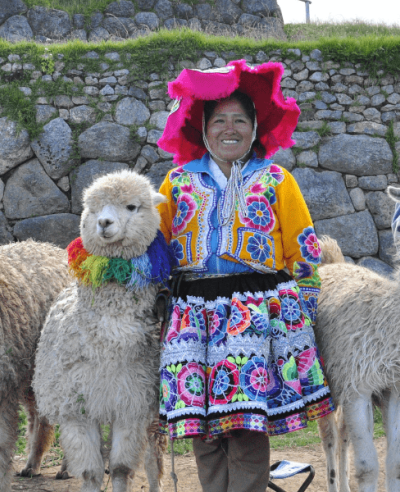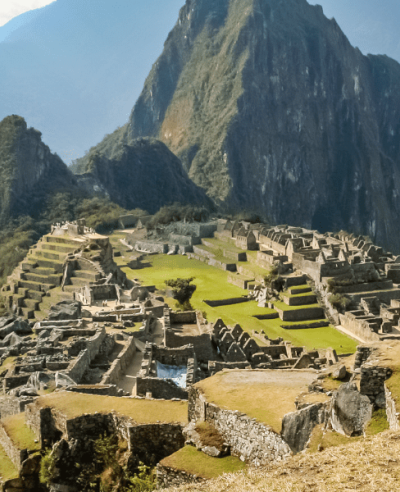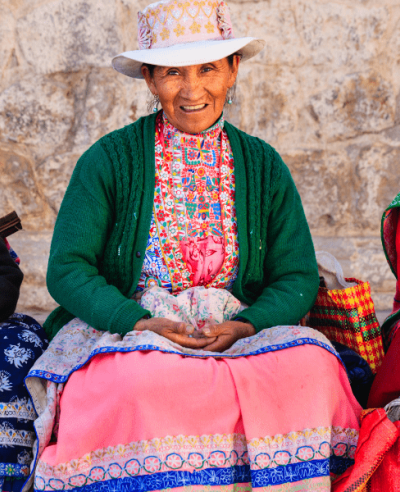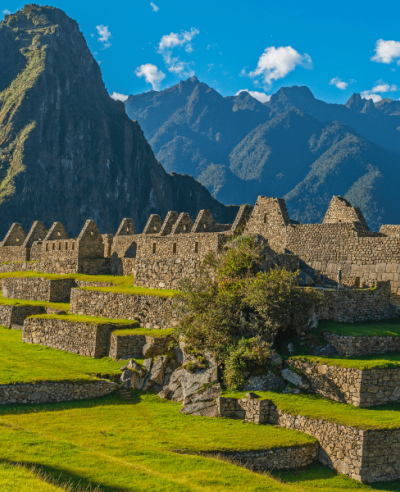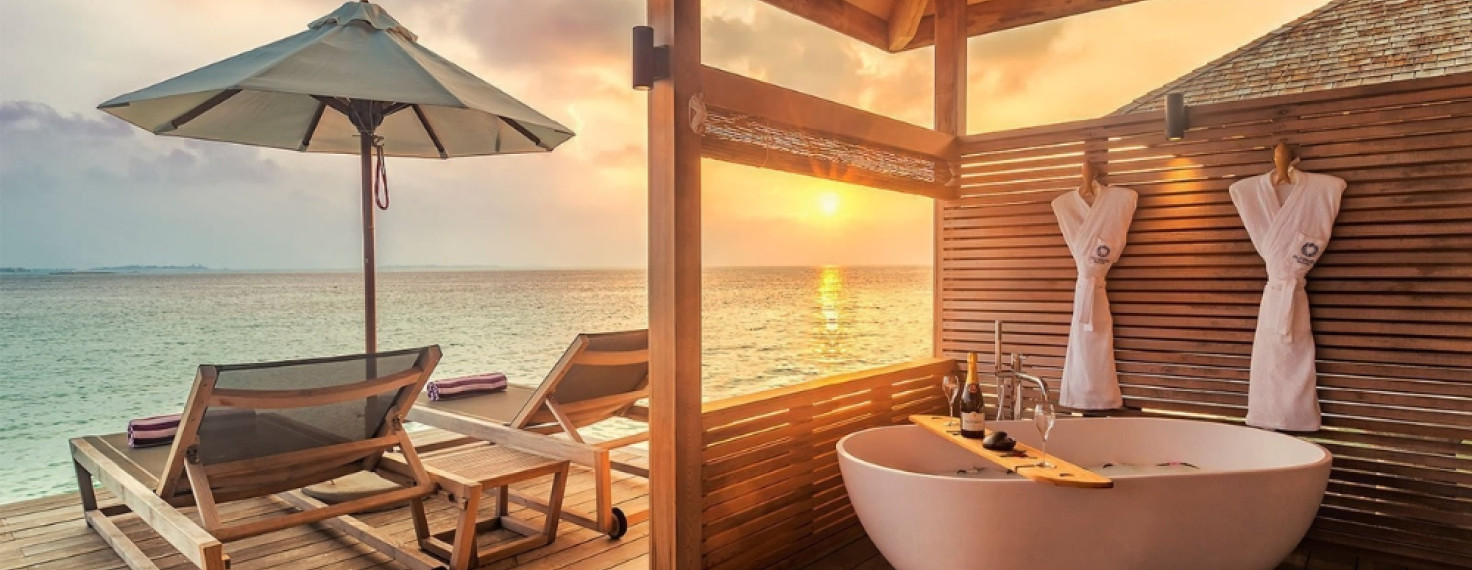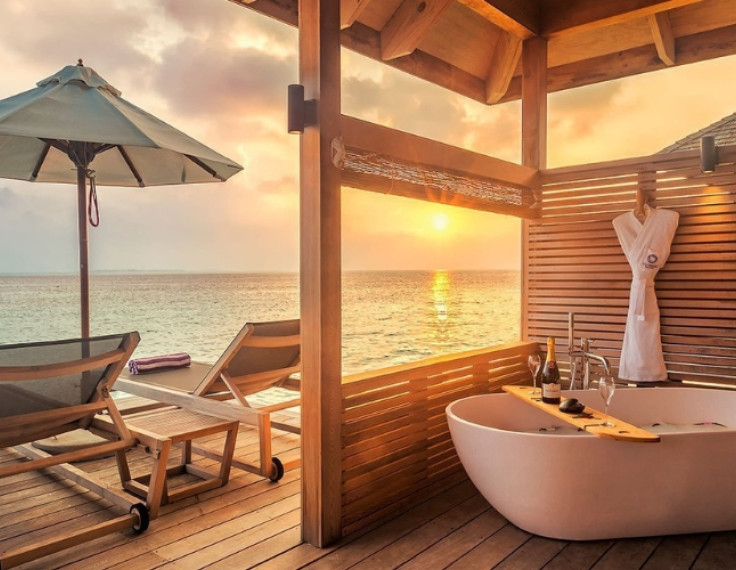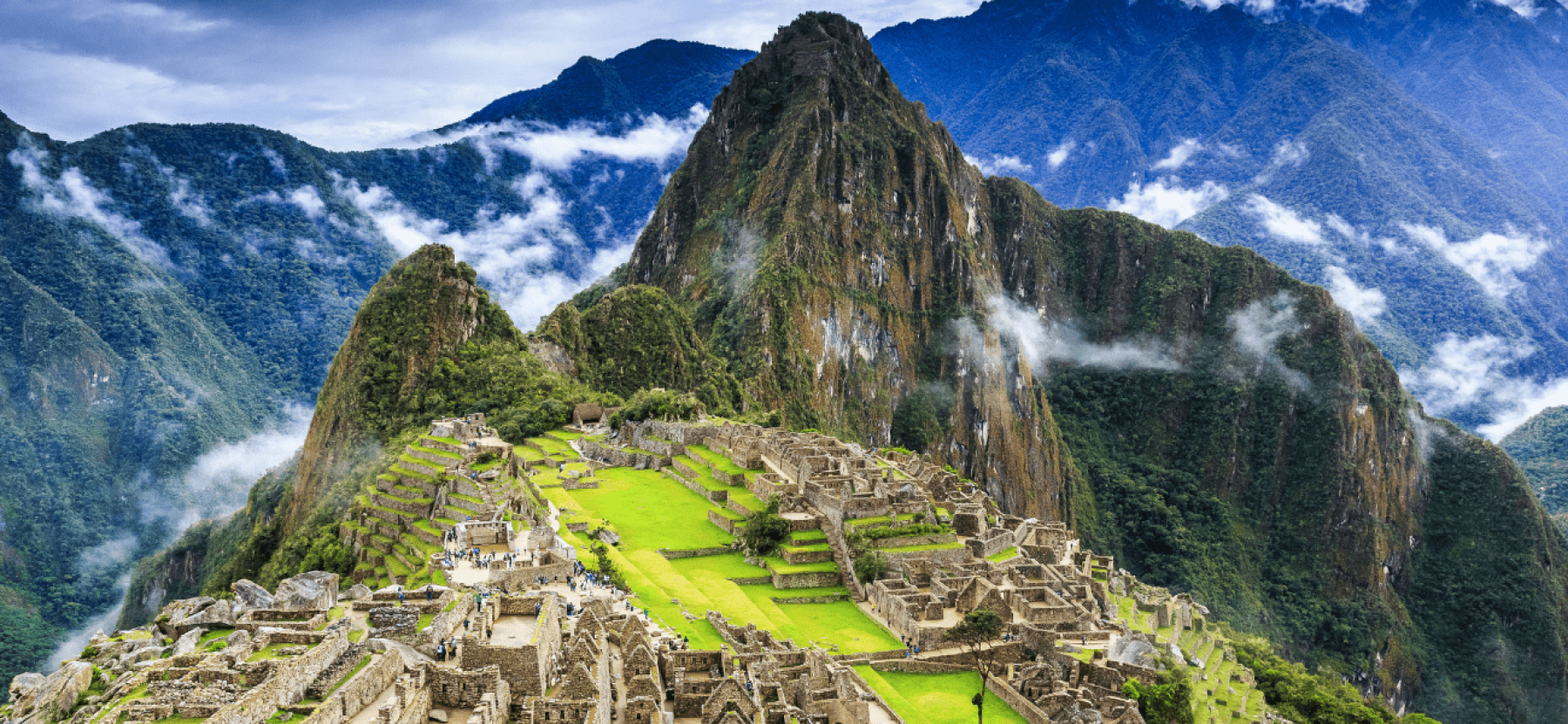
Peru
Peru
Peru's Andes mountains, arid deserts, amazon jungle, and pacific coast, each produced distinct civilizations. Peru is rich in history, culture, and nature's best-kept secrets including Machu Picchu.
Our Classic Peru tour is a great introduction to one of the many highlights of Peru and unarguably the most famous one, Machu Picchu. During this tour, you will get a deep dive into the history and culture and gastronomy of the country and you will witness some of the most beautiful areas of Peru's Andes region including Cusco and the Sacred Valley.
Our discover Peru tour is a great introduction to one of the many highlights of Peru and unarguably the most famous one, Machu Picchu. During this tour, you will get a deep dive into the history and culture of the country and you will witness some of the most beautiful areas of Peru's Andes region.
Our Pure Peru tour will tickle all your senses. You will taste some of Peru's most delicious dishes, and even prepare them yourself during a cooking class in Cusco, visit the famous lake Titicaca and of course you wont miss out on Machu Picchu.
Our Ultimate Peru tour takes you to all of the highlights. From the capital city of Lima, to the southern coast, the Andes mountains into the Amazon jungle, this tour will really take you on that deep dive into the country, its culture, history and cuisine.
Discover Peru
Peru is stunning and nature lovers can eat their hearts out in this South American country. The Andes mountains alone provide fantastic views, you can look out over the largest South American lake. One minute you are in the desert, the next day you are in the middle of the deepest canyon in the world, Colca Canyon. But traveling through Peru is also an introduction to authentic Indians, a visit to a world-famous Inca ruin, and with a bit of luck an encounter with the impressive condor.
Probably the most famous landmark to visit on your Peru tour is Machu Picchu, the "hidden" or "disappeared" city that is unique due to the fact that the Spanish conquerors never discovered and therefore not destroyed this Inca stronghold. The city's location, in the middle of the Andes Mountains, is just as beautiful and mysterious as the Inca ruins themselves.
Tourists traveling in Peru often end up at Lake Titicaca on the border with Bolivia. This blue lake is the highest navigable lake in the world. Furthermore, from Pisco, you can take a boat trip to the Ballestas Islands, where you will find seals, penguins, and sea birds.
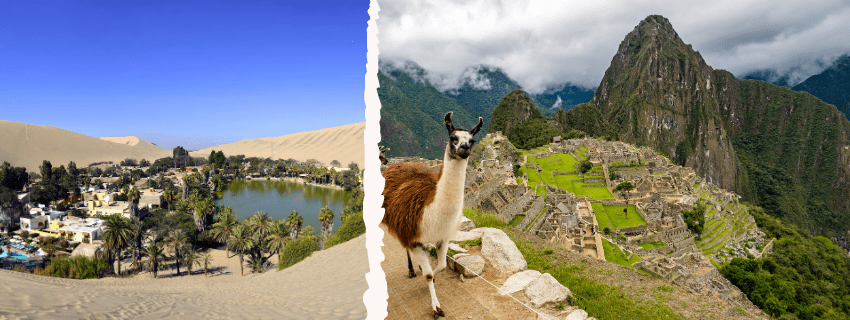
Practical information Peru
Itineraries While we intend to adhere to the route described in your contract, there is a certain amount of flexibility built into the itinerary and on occasion, it may be necessary, or desirable to make alterations.
The contract is a general guide to the tour, region and proposed itinerary any mention of specific wildlife is by no means a guarantee that they will be encountered, as we can never guarantee what mother nature has to offer us.
Additionally, any travel times listed are approximations only and subject to vary due to local circumstances.
Accommodation If a hotel is unexpectedly fully booked, we will always contact you before booking an alternative. We will always offer alternatives of the same level and value for money.
Kindly note that water is scarce in many parts of the world, so we always recommend taking short showers and reuse towels if possible.
Emergency Contact Should you need to contact Your Travel Nation during a situation of dire need. If you do not receive an immediate answer for any reason, please leave a detailed message and contact information, so we may return your call and assist you as soon as possible. We have an emergency line, which will connect you directly with our office.
+1 757 656 3391
Luggage You will be on the move a lot, so our advice is to pack as lightly as possible. Your baggage should be restricted to one medium-sized rolling bag, duffle bag or backpack, maximum 15kg, plus a daypack. Luggage limits on airlines are strictly enforced and space on vehicles is limited.
Packing list
Documents:
• Flight info (Printouts of e-tickets may be required at the immigration)
• Insurance info (With photocopies)
• Passport (With photocopies)
• Required visas or vaccination certificates (With photocopies)
• Copy of your contract
Essentials:
• Any medication you might need: This should include medication for possible common situations like headaches or diarrhoea;
• Sunblock, sunglasses, hat and lip balm.
• Your electronic devices and chargers.
For camera and lenses; we recommend bringing a wide lens (about 17-55mm) for those scenery pictures, and GoPro for those action shots; Renting a camera is not possible. Please ensure your camera equipment is appropriate for different weather conditions;
• Clothes: Comfortable and casual clothing. You should pack T-shirts, shirts with long sleeves, jeans, a sweater and a jacket (for the cold mornings), swimwear (if the accommodation you selected has a pool or if you do a beach extension) and comfortable hiking shoes;
• Insect repellent;
• Refill water bottle;
• Adaptor for A and C Type plugs.
Laundry Hand washing of clothes can be done at most of the hotels where you will stay. We recommend you bring a non-polluting/biodegradable soap, as well as a roll of simple string to act as a drying line for your clothes. If you arrive in the late afternoon, or if there is poor weather, it may not be possible for your clothes to completely dry. Your hotels may also have a laundry service available at an additional fee.
Visa & Entry requirements Normally, you don’t need a visa to travel if the purpose of the visit is tourism. If you’re travelling for any other purpose, check entry clearance requirements with the Peruvian Consulate-General in London. A passport with six months validity is required to enter Peru when departing from the United States or any other country. Migraciones (Immigration) authorities may also require evidence of return/onward travel.
Insurance A travel insurance is highly recommended when travelling. When selecting a travel insurance policy please bear in mind that we highly recommend good medical coverage and repatriation and emergency rescue. We strongly recommend that the policy also covers personal liability, cancellation, curtailment and loss of luggage and personal effects.
We don’t issue any insurances; however, we recommend using www.worldnomads.com
Health We recommend you contact your family physician, or your local travel clinic for the most up-to-date health information at least three months before departure or in case of a last-minute tour, as soon as you confirm your travels. Travellers are also advised to carry a basic first-aid kit and hand sanitisers/antibacterial wipes on their travels. Medical facilities are basic throughout these countries. For your own safety, we strongly recommend that you advise your local guide of any medical condition that may affect you while travelling. Your local guide will be able to inform you of local health advisories (e.g. drinking water quality). Please ensure you have all the inoculations recommended by your doctor.
Allergies and dietary restrictions This is something we take very seriously. Upon booking with us, we will send you a form in which you will be able to indicate any dietary preference or restriction or any specific request you might have. We will then provide that information in advance to all the hotels.
Safety and Security Many national governments provide a regularly updated advice service on safety issues involved with international travel. We recommend that you check your government's advice for their latest travel information before departure.
We strongly recommend the use of a neck wallet or money belt while travelling, for the safe keeping of your passport, air tickets, bank cards, cash and other valuable items. Leave your valuable jewellery at home - you won't need it while travelling. Many of the hotels we use have safety deposit boxes which is the most secure way of storing your valuables. A lock is recommended for securing your luggage.
Illegal drugs will not be tolerated on any trips. Possessing or using drugs not only contravenes the laws of the land but also puts the rest of your group at risk. Smoking marijuana and opium is a part of local culture in some parts of the world but is not acceptable for our travellers. Our philosophy of travel is one of respect towards everyone we encounter and in particular the local people who make the world the special place it is. The exploitation of prostitutes is completely contrary to this philosophy. Our local guides have the right to expel any member of the group if drugs are found in their possession or if they use prostitutes.
Photography and drone laws Please refrain from taking photos of police stations, airports, bus stations, immigration or border crossings, army barracks and personnel, or any government building. It is against the law and will result in the minimum of your film and camera being confiscated. Drone use is allowed in Peru but several drone laws need to be followed when flying in the country.
Electricity In Peru the power plugs and sockets are of type A and C. Type A: mainly used in North and Central America, China and Japan. This socket only works with plug A.Type C: also known as the standard "Euro" plug. This socket also works with plug E and plug F. The standard voltage is 220 V and the standard frequency is 60 Hz.
Religion Christianity is the largest religion in Peru.
Climate In Peru, a country located just south of the Equator, there are three climate zones:
- a desert coastal strip (called la Costa), with a mild climate, cloudy and foggy in winter and pleasantly warm in summer;
- the Andean zone (la Sierra), more or less cold depending on altitude;
- finally, the large eastern area is covered by the Amazonian forest (la Selva), with a hot and humid climate throughout the year.
Best time to visit The best time to visit Peru is during the dry season between May and October, especially if you plan to go on a trek. It is a wonderful time, with sunny days and bright blue skies, but early booking is crucial because it’s the peak season. Visitors will notice more rain between November and April, with the wettest months being January and February. Travel at this time does offer the advantage of fewer visitors, greener scenery, and some lower rates for flights and hotels.
Plastic bags Plastic bags are banned from entering Peru. However, plastics carrier items known as “Ziplock bags” that are specifically used to carry toiletries will be permitted as they are expected to remain in the permanent possession of visitors and are not expected to be disposed of in the country.
Money and currency The currency of Peru is the nuevo sol. ATMs are all over Peru. Visa is the most widely accepted debit or credit card in Peru; there will be fees associated with each withdrawal. Please consider your own spending habits when it comes to allowing for drinks, shopping and tipping. We always recommend carrying enough cash if you would like to pay for something in a remote place and the credit card machine cannot connect to any network. In Peru, merchants accepting credit cards will often add between 5% and 10% to the bill. Paying cash is often better value.
Tipping Tipping isn’t particularly common in Peru, but there are certain situations in which a tip is appropriate. Waiters in higher-end restaurants, tour guides and staff in top-end hotels often expect a tip, whereas taxi drivers and staff in small family-run restaurants do not.
Dress code What you wear on a day-to-day basis in Peru is entirely up to you. There’s no real etiquette when it comes to clothing in Peru, and no strict religious or social taboos to bear in mind. But people will judge you to a certain extent depending on what you’re wearing, as they do across the globe.
Why book with us?
Great value for money
With our partners being on the ground and getting the best prices for you, we assure you that our prices are unbeatable.
Travel with Care
Not only do we care about our guests and their experience, the world itself is one of our main concerns.
Customised itineraries
Everyone is different and therefore no request is too crazy. Customise your trip down to the finest detail.
Need any help booking? Call us anytime: +1 (757)-656-3391
